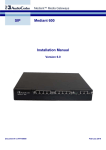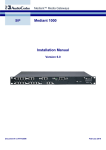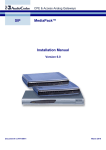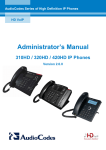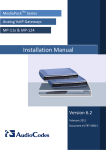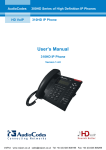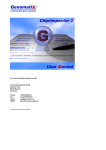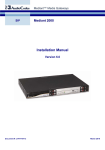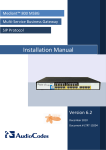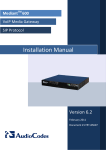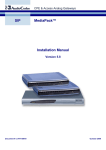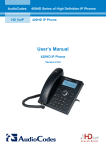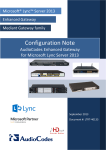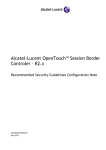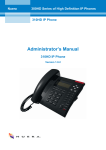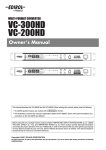Download Release Notes
Transcript
AudioCodes HD VoIP 300HD Series of High Definition IP Phones 310HD and 320HD IP Phones Release Notes 300HD Series IP Phones Version 1.6.0 Release Notes Contents Table of Contents 1 Introduction .......................................................................................................................... 7 1.1 Version 1.6.0 ............................................................................................................................ 9 1.1.1 1.1.2 1.1.3 1.1.4 1.1.5 1.2 1.3 1.4 2 Features Specific to 320HD IP Phone ........................................................................................... 9 Features Specific to 310HD IP Phone ........................................................................................... 9 Features Common to 310HD and 320HD IP Phones .................................................................... 9 New Configuration Parameters .................................................................................................... 11 Modified Configuration Parameters ............................................................................................. 16 Specifications ......................................................................................................................... 17 Resolved Constraints ............................................................................................................. 19 Known Limitations .................................................................................................................. 20 Previous Versions ............................................................................................................. 23 2.1 Version 1.4.1 .......................................................................................................................... 23 2.1.1 2.1.2 2.1.3 2.1.4 2.1.5 2.1.6 2.2 Version 1.4.0 .......................................................................................................................... 30 2.2.1 2.2.2 2.2.3 2.2.4 2.3 About Version 1.0.2 ..................................................................................................................... 37 Known Limitations in Version 1.0.2 .............................................................................................. 37 Version 1.0.1 .......................................................................................................................... 38 2.6.1 2.6.2 2.7 About Version 1.2.1 ..................................................................................................................... 35 Known Limitations in Version 1.2.1 .............................................................................................. 36 Version 1.0.2 .......................................................................................................................... 37 2.5.1 2.5.2 2.6 About Version 1.2.2 ..................................................................................................................... 33 Known Limitations in Version 1.2.2 .............................................................................................. 34 Version 1.2.1 .......................................................................................................................... 35 2.4.1 2.4.2 2.5 Features Specific to 320HD IP Phone ......................................................................................... 30 Features Specific to 310HD IP Phone ......................................................................................... 30 Features Common to 310HD and 320HD IP Phones .................................................................. 30 Known Limitations in Version 1.4.0 .............................................................................................. 31 Version 1.2.2 .......................................................................................................................... 33 2.3.1 2.3.2 2.4 Features Specific to 320HD IP Phone ......................................................................................... 23 Features Specific to 310HD IP Phone ......................................................................................... 23 Features Common to 310HD and 320HD IP Phones .................................................................. 23 New Configuration Parameters .................................................................................................... 25 Modified Configuration Parameters ............................................................................................. 27 Known Limitations ........................................................................................................................ 28 About Version 1.0.1 ..................................................................................................................... 38 Known Limitations in Version 1.0.1 .............................................................................................. 39 Version 1.0.0 .......................................................................................................................... 40 2.7.1 2.7.2 Version 1.6.0 About Version 1.0.0 ..................................................................................................................... 40 Known Limitations in Version 1.0.0 .............................................................................................. 41 3 January 2012 300HD Series IP Phones List of Tables Table 1-1: Version 1.6.0 New Parameters ................................................................................................................. 11 Table 1-2: Version 1.6.0 Modified Parameters ........................................................................................................... 16 Table 1-3: AudioCodes 300HD IP Phone Software Specifications ............................................................................ 17 Table 2-1: Version 1.4.1 New Parameters ................................................................................................................. 25 Table 2-2: Version 1.4.1 Modified Parameters ........................................................................................................... 27 Table 2-3: Version 1.2.2 New Parameters List ........................................................................................................... 33 Table 2-4: Version 1.2.2 Modified Parameters List .................................................................................................... 33 Release Notes 4 Document #: LTRT-08212 Release Notes Notices Notice This document presents the new features of the AudioCodes 300HD Series IP Phones for Version 1.6.0. Information contained in this document is believed to be accurate and reliable at the time of printing. However, due to ongoing product improvements and revisions, AudioCodes cannot guarantee accuracy of printed material after the Date Published nor can it accept responsibility for errors or omissions. Updates to this document and other documents as well as software files can be viewed by registered customers at www.audiocodes.com/downloads. © Copyright 2012 AudioCodes Ltd. All rights reserved. This document is subject to change without notice. Refer to any current documentation that may be included with your hardware delivery. Date Published: January-30-2012 Trademarks AudioCodes, AC, AudioCoded, Ardito, CTI2, CTI², CTI Squared, HD VoIP, HD VoIP Sounds Better, InTouch, IPmedia, Mediant, MediaPack, NetCoder, Netrake, Nuera, Open Solutions Network, OSN, Stretto, TrunkPack, VMAS, VoicePacketizer, VoIPerfect, VoIPerfectHD, What’s Inside Matters, Your Gateway To VoIP and 3GX are trademarks or registered trademarks of AudioCodes Limited. All other products or trademarks are property of their respective owners. WEEE EU Directive Pursuant to the WEEE EU Directive, electronic and electrical waste must not be disposed of with unsorted waste. Please contact your local recycling authority for disposal of this product. Customer Support Customer technical support and service are generally provided by AudioCodes’ Distributors, Partners, and Resellers from whom the product was purchased. For technical support for products purchased directly from AudioCodes, or for customers subscribed to AudioCodes Customer Technical Support (ACTS), contact [email protected]. Abbreviations and Conventions Each abbreviation, unless widely used, is spelled out in full when first used. Version 1.6.0 5 January 2012 300HD Series IP Phones Related Documentation Document Name 310HD IP Phone User's Manual v1.6.0 310HD IP Phone Administrator’s Manual v1.6.0 310HD IP Phone Quick Guide 320HD IP Phone User's Manual v1.6.0 320HD IP Phone Administrator's Manual v1.6.0 320HD IP Phone Quick Guide Release Notes 6 Document #: LTRT-08212 Release Notes 1 1. Introduction Introduction AudioCodes 300 Series of High Definition (HD), Voice-over-IP (VoIP) IP Phones are available in two models - the 310HD and 320HD. AudioCodes 300HD Series of HD IP Phones offers a new dimension of voice call quality and clarity for the IP Telephony market. This new series of IP Phones further expands AudioCodes’ VoIP product offerings for the Enterprise and Service Provider markets. As a natural addition to the AudioCodes’ Media Gateway, Media Server and Multi-Service Business Gateway (MSBG) products, the AudioCodes 300HD Series of HD IP Phones enable Systems Integrators and end-customers to build end-to-end solutions that rely on AudioCodes’ technological advantage and proven track record in providing state-of-the-art, high quality, and interoperable VoIP products. The AudioCodes 300HD Series of HD IP Phones meet a growing demand for HD VoIP solutions in enduser phones and terminals, improving the productivity and efficiency of business communications with new quality standards set by the HD voice technology. Version 1.6.0 7 January 2012 300HD Series IP Phones Reader's Notes Release Notes 8 Document #: LTRT-08212 Release Notes 1. Introduction 1.1 Version 1.6.0 1.1.1 Features Specific to 320HD IP Phone The 320HD IP Phone includes the following new features: 1.1.2 The Busy Lamp Field (BLF) has been added to the FreeSwitch application server. The "Always on" option has been added to the LCD backlight timeout. URL dialing is now supported. Multiple language support - The phone’s LCD display interface supports the following languages: English, Spanish, Italian, French, Portuguese, German, Russian, Ukraine, Hebrew and Polish. Features Specific to 310HD IP Phone The 310HD IP Phone offers the following new features: 1.1.3 Multiple language support - The phone’s LCD display interface now supports the following languages: English, Spanish, Italian, French, Portuguese, German, Russian, Ukraine and Polish. (The Russian language support is applicable only with the latest 310HD hardware revision. For more information please refer to Product Notice 0138 http://www.audiocodes.com/filehandler.ashx?fileid=1905532.) The local extension is now displayed while on the idle screen. Features Common to 310HD and 320HD IP Phones The 310HD and 320HD IP Phones offer the following new features: New features specific to AudioCodes solution for Microsoft® Lync™: • Locking/unlocking of the phone using a PIN code • Support for SSRTP • Visibility on the phone’s LCD of the end user Lync status • Modification of the Lync status via the phone user interface • Narrowband and Wideband RTA (Microsoft RT Audio) support from Version 1.4.1 Online directory support with LDAP (Lightweight Directory Access Protocol). The 300HD IP Phone can now retrieve online corporate directory phone book information. The following security enhancements have now been added: • IEEE 802.1X Network Access Control support • Configuration file encryption • Encryption of passwords in the configuration Support for firmware upgrade via the Web interface. You can now browse to the new software image file via the Web interface, to start the upgrade. The Web interface VoIP Status page is now available. Daylight Saving improvements – new modes of operation have been added. Electronic hook switch support (DHSG) is now supported. This feature is applicable only with the latest 310HD and 320HD hardware revisions. For more information please refer to Product Notice 0138 (http://www.audiocodes.com/filehandler.ashx?fileid=1905532). Remote network conferencing according to RFC 4240 is now supported. Transferring a "call waiting" (while a previous call is on-hold) to a third party is now supported. When muting a call, comfort noise is now sent to the remote party. When receiving a call, the user can mute the ring tone, in addition to the already supported option to reject the call. The user can load/save speed dial information via the Web interface. Version 1.6.0 9 January 2012 300HD Series IP Phones The user can load/save corporate/personal directory information via the Web interface. The LCD progress bar notification during firmware upgrade has now been added. Simplified process for private label adjustments and customization (e.g., you can now change the phone splash screen logo, user agent, etc). Enhanced debug logging mechanism. The administrator can now retrieve logging information for specific components and set the required severity. Note: The VoIP application’s event logging mechanism has been removed from the main IP Phone firmware. To perform logging (for debugging and diagnostic purposes), a special firmware version is available. Broken RTP connection detection has now been added. A method of dialing when the phone is on-hook is now configurable. A default answering device is now configurable. Release Notes 10 Document #: LTRT-08212 Release Notes 1.1.4 1. Introduction New Configuration Parameters The table below lists the new configuration parameters supported in Version 1.6.0: Table 1-1: Version 1.6.0 New Parameters Parameter Name Description system/ldap/enabled Enables or disables LDAP. system/ldap/server_address Defines the IP address or URL of the LDAP server. system/ldap/port Defines the LDAP service port. system/ldap/user_name Defines the user name used for the LDAP search request. system/ldap/password Defines the password of the search requester. system/ldap/base Defines the access point on the LDAP tree. system/ldap/name_filter Specifies your search pattern for name look ups. For example: When you type in the following field: (&(telephoneNumber=*)(sn=%)), the search result includes all LDAP records, which have the ‘telephoneNumber’ field set and the ‘(“sn”-->surname)’ field starting with the entered prefix. When you type in the following field: (|(cn=%)(sn=%)), the search result includes all LDAP records which have the (“cn”-->CommonName) or (“sn”-->Surname) field starting with the entered prefix. When you type in the following field: (!(cn=%)), the search result includes all LDAP records which “do not” have the “cn” field starting with the entered prefix. system/ldap/name_attrs Specifies the LDAP name attributes setting, which can be used to specify the “name” attributes of each record which is returned in the LDAP search results. When you type in the following field, for example, cn sn displayName”, this requires you to specify ‘cn->commonName’. This is the Full name of the user, sn->Surname, last name or family name and “displayName” fields for each LDAP record. system/ldap/number_filter Specifies your search pattern for number look ups. When you type in the following field, for example, (|(telephoneNumber=%)(Mobile=%)(ipPhone=%)), the search result is all LDAP records which have the “telephoneNumber” or “Mobile” or “ipPhone”field match the number being searched. When you type in the following field: (&(telephoneNumber=%)(sn=*)), the search result is all LDAP records which have the “sn” field set and the “telephoneNumber” match the number being searched. Version 1.6.0 11 January 2012 300HD Series IP Phones Parameter Name Description system/ldap/number_attrs Specifies the LDAP number attributes setting, which can be used to specify the “number” attributes of each record which is returned in the LDAP search results. When you type in the following field, for example, Mobile telephoneNumber ipPhone, you must specify ‘Mobile’, ‘telephoneNumber’ and ‘ipPhone’ fields for each LDAP record. system/ldap/display_name Specifies the format in which the “name, e.g. “Mike Black” of each returned search result is displayed on the IP Phone. When you type in the following field, for example:%sn, %givenName, the displayed result returned should be “Black, Mike”. system/ldap/max_hits Specifies the maximum number of entries expected to be sent by the LDAP server (this parameter is sent to the LDAP server). system/ldap/sorting_result Sorts the search result by display name on the client side. system/ldap/predict_text Appears in the configuration file; however, it is currently not supported. system/ldap/search_timeout Defines the time-out value for LDAP search (this parameter is sent to the LDAP server). system/ldap/ui/use_right_arrow_active_search Appears in the configuration file; however, it is currently not supported. system/ldap/lookup_incoming_call Appears in the configuration file; however, it is currently not supported. system/ldap/call_lookup Performs an LDAP search during call (search the display name for a number). system/ldap/country_code Defines the country code prefix added for number search. system/ldap/area_code Defines the area code prefix added for number search. system/ldap/minimal_name_search_length Starts to perform an LDAP search after x characters are input. system/ldap/send_queries_while_typing Sends an LDAP search each time the user presses a key (all keys with both number and letters). /network/lan/_802_1x/md5_password Defines the password for md5 mode. (Leave blank if no password). /network/lan/_802_1x/tls_identity Defines the Identity for TLS mode. (optional) /network/lan/_802_1x/root_ca_url Defines the URL for the file that contains root and intermediate Certificate. /network/lan/_802_1x/trust_ca_url Defines the URL for the file that contains a trust Certificate. /network/lan/_802_1x/local_ca_url Defines the URL for the file that contains a local Certificate. /network/lan/_802_1x/private_key_url Defines the URL for the file that contains the private key. Release Notes 12 Document #: LTRT-08212 Release Notes 1. Introduction Parameter Name Description /network/lan/_802_1x/private_key_password Optional: If the file that contains the private key is encrypted, then this is the password for decryption. /network/lan/port_mode Sets the LAN port mode. Valid values are : [AUTOMATIC] = Auto negotiation. [FULL_10] = 10Mbps + full duplex [FULL_100] = 100Mbps + half duplex [HALF_10] = 10Mbps + full duplex [HALF_100] = 100Mbps + half duplex /network/pc/port_mode Sets the PC port mode. See valid values above. /voip/line/[0-0]/extension_display Sets the string that is displayed for the local extension. If not set, the local extension display is the user ID (self number). /voip/dialing/on_hook_dialing Defines the dialing mode when the phone is on-hook and no audio device is selected (when the user enters digits on idle state). Valid values are: [Disable] = Ignore digits press. In order to initiate a call, the user selects the audio device by pressing speaker or headset keys or by picking headset. [Open_default_audio_device]= Default behavior – Start dialing via default audio device (usually speaker) activated. [Off_line_dialing] = Don`t activate the default audio device until pressing “dial” , DTMF tones are not heard and dialing related features ( such as “dialing timeout” , “dial complete key” , and more ) are disabled. /voip/signalling/sip/enable_sips Relevant for TLS only; if enabled, the request URI prefix is “sips:” otherwise, the prefix is “sip:” /voip/signalling/sip/subs_no_notify_timer Indicates the maximum time (in milliseconds) that a subscription waits from receiving a 2xx response for a SUBSCRIBE request, until receiving the first NOTIFY request. If the timer expires, the subscription terminates. /voip/dialing/allow_calling_self_extension If disabled (default), calling the self number (user ID) is blocked. If enabled, the phone sends the invite although it is for its own extension. (In some proxies, this is how you access voice mail). /voip/media/broken_connection_detection If enabled, an active call is automatically disconnected if no RTP packet is received within the pre-defined time. /voip/media/broken_connection_timeout If no RTP packet arrives for an active call within this timeout (in seconds), the connection is considered broken and the call is disconnected. Version 1.6.0 13 January 2012 300HD Series IP Phones Parameter Name Description /voip/services/busy_lamp_field/color_settings Relevant for presence feature. Valid values: [OPTION_1] = BLF refers the presence state of remote parties. [OPTION_2] = BLF refers the call state of remote parties (default). /voip/services/call_pickup/enabled Allows call pickup by pressing on the relevant BLF key when the state of the remote phone is “ringing”. /voip/services/conference/mode Sets the conference mode (when establishing 3 Way Conference). [LOCAL] = phone establishes the conference by itself. [REMOTE] = phone uses remote media server for establishing the conference. /voip/services/conference/conf_ms_addr Defines the Media server for establishing remote conference. Relevant only in case the conference mode is REMOTE. /voip/services/reject_code Configures the reject code that the IP Phone sends when pressing the “reject” SK or while DND is activated. Valid values are: [CODE_603] [CODE_486] /voip/answer_device Sets the default audio device to answer or initiate a new call when no explicit audio device is set. For example : When pressing ANS SK. When initiating a call by speed dial key, call history or phone directory. Answering talk event or auto-answer. When starting to dial in “on hook” mode. Valid values are : [SPEAKER] [HEADSET] /voip/call_list_support_uri Displays the URI from remote party on the screen and keeps it in the call history. /system/aoc/enabled Enables Advice of Charge feature. /system/aoc/currency Sets the desired currency for Advice of Charge display. /system/aoc/ratio Sets the conversion ratio from local currency. /voip/media/srtp/use_MKI Relevant for SRTP. Defines the Master Key Index from SDP. /voip/media/srtp/MKI_length Relevant for SRTP. Defines the Maximum length of the Master Key Index. /system/lock/[0-0]/enabled Enables the “phone lock” feature, relevant for supporting servers only. Release Notes 14 Document #: LTRT-08212 Release Notes 1. Introduction Parameter Name Description /system/server_lock_error_code Refers to a specific error code from the server as the “lock” operation trigger. The error code should be 4XX SIP. /system/lock/[0-0]/allow_incoming_calls Allows incoming calls when the phone is locked. If allowed, the user needs to enter an unlock password to answer an incoming call. If not allowed, the incoming call is automatically rejected by the phone. /system/action_url/lock_status Sets the action URI to get lock status from phone. /system/action_url/lock Sets the action URI to lock the phone. /system/action_url/unlock Sets the action URI to unlock the phone. /system/current_user_presence_status/enabled Enables the “presence” feature. DND SK is replaced by “status”; the phone shows and publishes the presence status. /voip/dialing/speed_dial/double_press/enabled Relevant for 310HD only: If enabled, the first speed dial press displays the number and only the second press dials. If disabled, the first press dials. Version 1.6.0 15 January 2012 300HD Series IP Phones 1.1.5 Modified Configuration Parameters The table below lists the configuration parameters from the previous version that have been modified in Version 1.6.0: Table 1-2: Version 1.6.0 Modified Parameters Parameter Name /system/syslog/log_watchdog_events Description Replaced by: /system/syslog/component/watchdog /management/tr069/activation_key Replaced by: /system/activation_keys/tr069 /voip/default_audio_device Replaced by: /voip/answer_device /system/ntp/daylight_saving/activate Replaced by: /system/daylight_saving/activate /system/ntp/daylight_saving/offset Replaced by: /system/daylight_saving/offset /system/ntp/daylight_saving/start_date/month Replaced by: /system/daylight_saving/start_date/month /system/ntp/daylight_saving/start_date/day Replaced by: /system/daylight_saving/start_date/day /system/ntp/daylight_saving/start_date/hour Replaced by: /system/daylight_saving/start_date/hour /system/ntp/daylight_saving/start_date/minute Replaced by: /system/daylight_saving/start_date/minute /system/ntp/daylight_saving/end_date/month Replaced by: /system/daylight_saving/end_date/month /system/ntp/daylight_saving/end_date/day Replaced by: /system/daylight_saving/end_date/day /system/ntp/daylight_saving/end_date/hour Replaced by: /system/daylight_saving/end_date/hour /system/ntp/daylight_saving/end_date/minute Replaced by: /system/daylight_saving/end_date/minute Release Notes 16 Document #: LTRT-08212 Release Notes 1.2 1. Introduction Specifications AudioCodes 300HD IP Phone software specifications are summarized in the following table: Table 1-3: AudioCodes 300HD IP Phone Software Specifications Feature Details VoIP Signaling Protocols SIP: RFC 3261, RFC 2327 (SDP) Data Protocols IPv4, TCP, UDP, ICMP, ARP, DNS and DNS SRV for SIP Signaling SIP over TLS (SIPS) 802.1p/Q for Traffic Priority and QoS VLAN Discovery Mechanism (CDP, LLDP) ToS (Type of Service) field, indicating desired QoS DHCP Client NTP Client Media Processing Telephony Features Version 1.6.0 Voice Coders: G.711, G.723.1, G.729A/B, G.722, RTA. Acoustic Echo Cancelation: G.168-2004 compliant, 64-msec tail length Adaptive Jitter Buffer 300 msec Voice Activity Detection Comfort Noise Generation Packet Lost Concealment RTP/RTCP Packetization (RFC 3550, RFC 3551), SRTP (RFC 3711) DTMF Relay (RFC 2833) Call Hold / Un-Hold Call Transfer Three-way Conferencing (with local mixing) Redial Caller ID Notification Call Waiting Indication Message Waiting Indication (including MWI LED) Local and Corporate Directories Automatic On-hook Dialing Automatic Answering (Alert-Info header and “talk” event) CWRR (Call Waiting Reminder Ring) Secondary Dial Tone Call Logs: Missed/Received Calls and Dialed Numbers TM Speed Dial (Including BLF support for Asterisk and BroadWorks ) Dial Plan URL Dialing Advice of Charge (AOC) Call Forward (Unconditional, Busy, No Answer) Redundant SIP Proxy Mechanism Remote conferencing (RFC 4240) Multiple Lines for 320HD (currently supports up to 4 lines) 17 January 2012 300HD Series IP Phones Feature Details Configuration/ Management Debugging Tools Release Notes TR-069 for Remote Configuration and Management LCD Display User Interface Language Support (Various Languages) Web-based Management (HTTP/HTTPS) Auto-Provisioning (via TFTP, FTP, HTTP, and HTTPS) for firmware and configuration file upgrade DHCP Options (66, 67, and 160) for Auto-provisioning DHCP Options (12, 60, and 77) for Device Information LDAP (Lightweight Directory Access Protocol) Private Labeling Mechanism Configuration File Encryption (Entire file and individual parameters) Syslog Mechanism DSP Recording Port Mirroring VoIP Status Web page 18 Document #: LTRT-08212 Release Notes 1.3 1. Introduction Resolved Constraints The following constraints from previous versions have now been resolved in Version 1.6.0: Loading the configuration file through the Web interface takes ~2 minutes. RFC 2833 DTMF’s are not being sent between the parties in three-way conferencing. SUBSCRIBE messages are sent prior to successful registration. Multiple lines (applicable for the 320HD) resolved constraints: • Call Forward is not supported in multi-line mode. The phone does not support manual date and time configuration via the Web interface. Changing SSRC during three-way conferencing causes the call to drop. IP Phone stops sending subscription messages when receiving '403' messages from the server. When SIP over TLS is enabled, MWI Subscription messages are not sent over TLS. Web interface resolved constraint: • Version 1.6.0 When configuring DNS servers, the phone must be rebooted manually for the new values to take effect. CWRR does not function correctly in several advanced scenarios, for 310HD. 19 January 2012 300HD Series IP Phones 1.4 Known Limitations Version 1.6.0 includes the following known constraints: When upgrading from older versions (e.g., older than 1.4.0), the configuration parameters restore to default values. When upgrading from Version 1.2.2 to Version1.6.0, the phone configuration file automatically converts to the Version 1.6.0 version format, except for the following parameters: • NTP settings • Volume settings • Call forward settings The VoIP application’s event logging mechanism has been removed from the main IP Phone firmware. To perform logging (for debugging and diagnostics), a special firmware version is available. A humming noise can be heard on the headset when using the 3COM PoE device model PW130 on the following hardware models and revisions: • 320HD Revisions 9 and 12 (PN GGWV00343). • 310HD Revisions 8, 11 and 12 (PN GGWV00344). This issue has been resolved in the latest hardware revisions. Multiple lines limitations: • Do not Disturb (DND) is not working when more than 1 line is configured. • Can’t transfer a second incoming call when more than 1 line is configured. • SIP NOTIFY messages with the “talk” event are not supported for multiple lines configuration. It is not possible to use the encryption tool on an Ubuntu host PC. The first call establishment after reboot is slower than for other calls. To ensure that the OPTIONS Keep-Alive feature is fully functional, the remote side must send a SIP response message. The message can be any response, for example, 501 “Not Implemented”. When the LAN cable is disconnected or the LAN link is down, a dial tone is played instead of a reorder tone. In recovery mode, the phone is unable to communicate with a TFTP server located on a Linux machine or on any other operating system that is not Microsoft Windows XP. When transferring a call, the transferred phone's LCD still displays a connection to the transferring phone and not to the new phone to which it is now connected. When performing a semi-attendant transfer, the transferred party receives a missed call indication from the first caller, even though the call was successfully transferred. The call log information is saved once daily and not after each occurrence. Volume settings, which are set through the VOLUME key, are not saved and are not active after a reboot. The interval values set for the MWI and BLF SUBSCRIBE SIP messages parameters ‘voip/services/msg_waiting_ind/expiraition_timeout’ and ‘voip/services/busy_lamp_field/subscription_period’ should not be lower than the minimum value allowed by the server, otherwise the phone does not respond correctly to a 423 SIP response. On some proxy servers, when performing a Semi-Attendant Transfer, the LCD display remains in a call until the call is fully transferred. TR-69 limitations: Release Notes • The task status of the ACS may not be updated correctly when loading configuration/firmware files. • Specific phone parameters cannot be configured through the ACS. 20 Document #: LTRT-08212 Release Notes 1. Introduction Participant(s) in a three-way conference call cannot be placed on hold. Once a conference call is established on a specific line, the user cannot toggle to another call on another line nor answer a call on another line for the duration of the conference call. During a conference call, pressing line keys and softkeys has no effect. To toggle to another line, the user must first end the conference or wait for one of the conference parties to disconnect (thereby, ending the conference call and establishing a regular call). Web interface constraints: • Version 1.6.0 Numerous interoperability issues exist in specific scenarios when operating with Web browsers other than Internet Explorer (e.g. Mozilla Firefox and Google Chrome). 21 January 2012 300HD Series IP Phones Reader's Notes Release Notes 22 Document #: LTRT-08212 Release Notes 2. Previous Versions 2 Previous Versions 2.1 Version 1.4.1 Note: To upgrade to Version 1.4.1, the phone must first be upgraded to Version 1.2.2 or 1.4.0 if an older version has been used. 2.1.1 Features Specific to 320HD IP Phone The 320HD IP Phone includes the following new features: The following features are now supported in multi-line mode: • Do Not Disturb (DND), Call Forwarding, three-way Conferencing, and Call Transfer. • Different ring tones can now be configured per line (extension). • Multiple languages - The phone’s user interface now supports Italian (in addition to the existing support for English, Spanish, Portuguese, German, French, Russian, and Ukraine). The following features are supported for various application servers: • Call Pickup for the Asterisk application server. • Busy Lamp Field (BLF) for the Metaswitch application server. 2.1.2 Lines can be configured using the configuration file, LCD display, or the Web interface. Each line supports 2 concurrent calls (instead of 1, as in Version 1.4.0). 8 concurrent calls are supported in total. Features Specific to 310HD IP Phone The 310HD IP Phone offers the following new features: 2.1.3 Multiple language support - The phone’s user interface now supports Italian and French (in addition to the existing support for English and Spanish). The entire Call History list can now be deleted. Features Common to 310HD and 320HD IP Phones The 310HD and 320HD IP Phones offer the following new features: Version 1.4.1 consist of several firmware files which support different voice codecs: • G.722, G.711, G.729 • G.711, G.729, G.723 • Narrowband and Wideband RTA (Microsoft RT Audio), G.711 Support for SIP over TLS (SIPS). Note that certificate files must be downloaded to the phone to enable this feature. Support for Secured RTP (SRTP). Link Layer Discovery Protocol (LLDP) – support is offered for VoIP VLAN only. Currently, LLDP and CDP are enabled by default. When upgrading from firmware version 1.4.0 to 1.4.1 or later, the phone’s configuration is retained. The “check-sync” through the SIP NOTIFY message mechanism has been modified. Upon receipt of a “check-sync” message, the phone immediately retrieves the configuration file and reboots if a new configuration is provided. In addition, the phone can be configured to reboot even if no configuration update is required. Version 1.6.0 23 January 2012 300HD Series IP Phones Improved registration mechanism: • When registration fails or the server does not respond, the timeout for re-registering is automatically reduced to a pre-configured value. • SIP OPTION messages are now sent periodically to the SIP server. If there is no response from the server, the phone immediately tries to re-register. This support is configurable (i.e., can be enabled or disabled). The Directory Web page is now available. New sequence of keys allows restoring the phone to factory default settings. Continuously pressing the VOLUME key adjusts the volume gradually. In the Call History menu, consecutive numbers appear only once. The number of calls from the specific contact is indicated in parenthesis. Daylight saving start and stop dates are now configurable. For monitoring, it is now possible to configure the internal Ethernet switch to operate in a hub-like mode, allowing LAN packets to be captured on the PC Ethernet port. Upon LAN link failure, the phone tears down active calls and re-registers itself. Automatic Answering support (using the SIP Alert-Info and Call-Info headers). Narrowband and Wideband Microsoft RTAudio (RTA) codec support – requires a special firmware. Partial DHCP support – allows configuration of static values which are not to be retrieved from the DHCP server. The Web interface can now be accessed through a secondary HTTP port (8080). The following advanced features are supported for the BroadWorks Application Server: • Session timer, according to Session Timers in Session Initiation Protocol (SIP) (RFC 4028) • Anonymous calls • Connected Line Restriction • Incoming Anonymous Call Block Several new configuration parameters have been added (see Section 2.1.4 on page 25). For more information about the new parameters, refer to the Administrator's Guide. Several configuration parameters have been modified in this version (see Section 2.1.5 on page 27). For more information about the modified parameters, refer to the Administrator's Guide. Release Notes 24 Document #: LTRT-08212 Release Notes 2.1.4 2. Previous Versions New Configuration Parameters The table below lists the new configuration parameters supported in Version 1.4.1: Table 2-1: Version 1.4.1 New Parameters Description Parameter Name system/ntp/time_display_format Determines the time display format of the clock displayed on the LCD. provisioning/certificate/private_key_uri Defines the URI for retrieving the certification private key. The certificate key must be included in a separate file that can be downloaded to the phone during provisioning. provisioning/certificate/ca_uri Defines the URI for retrieving the Certificate Authority (CA) key. The CA must be included in a separate file that can be downloaded to the phone during provisioning. management/telnet/enabled Enables telnet access to the phone. network/lan/dhcp/domain_name/enabled Enables defining a domain name. network/lan/dhcp/ip_address/enabled Enables defining the IP address. network/lan/dhcp/netmask/enabled Enables defining the network mask. network/lan/dhcp/gateway/enabled Enables defining the default gateway. network/lan/dhcp/primary_dns/enabled Enables defining the primary DNS. network/lan/dhcp/secondary_dns/enabled Enables defining the secondary DNS. network/lan/fixed_ip/domain_name Defines the domain name. network/lan/vlan/period Defines the time period in seconds between discovery messages when configured to CDP, LLDP or CDP and LLDP. network/lan/dhcp/ntp/server_list/enabled Enables the prioritization of the NTP server’s information received from the DHCP server (Option fields 42 or 4) over the static configuration (system/ntp/primary_server_address and system/ntp/secondary_server_address). network/lan/dhcp/ntp/gmt_offset/enabled Enables the prioritization of the NTP GMT offset information received from the DHCP server (Option field 2) over the static configuration (system/ntp/gmt_offset). network/pc_port_mirroring/enabled Enables port mirroring. voip/signalling/sip/tls_port Defines the local TLS SIP port for SIP messages. voip/signalling/sip/registration_failed_tim eout In case registration fails, this determines the interval between the register messages periodically sent until successful registration. Version 1.6.0 25 January 2012 300HD Series IP Phones Parameter Name Description voip/signalling/sip/semi_transfer_with_no _cancel/enabled Determines whether the semi-attendant transfer is performed without sending SIP CANCEL messages to the remote side. voip/signalling/sip/registrar_ka/enabled Determines whether to use registration Keep-Alive mechanism. voip/signalling/sip/registrar_ka/timeout Defines the registration Keep-Alive time interval (in seconds) between Keep-Alive messages. voip/media/srtp/enabled Enables Secured RTP (SRTP). voip/media/srtp/method Determines the SRTP encryption method to be used. voip/media/srtp/aria_support_enabled Enables the ARIA encryption method to the list of supported encryption the phone publishes. voip/media/allow_multiple_rtp Defines whether to allow multiple RTP streams from different remote ends to be play towards the phone on a single call. voip/media/ignore_rfc_2833_packets Defines whether to ignore playing DTMF when RFC 2833 packets arrive from the network. voip/services/application_server_type Determines the application server with which the phone operates (e.g., Metaswitch). voip/services/msg_waiting_ind/always_se nd_port If the SIP port is the default port (5060), remove it from the Request-URI of the MWI SUBSCRIBE message. voip/services/call_pickup/access_code Defines the sequence of phone keys for activating call pickup. voip/services/electronic_hook_switch/ena bled Enables the Electronic Hook Switch (DHSG) feature. voip/auto_answer/enabled Enables the Automatic Answering feature. voip/talk_event/enabled Enables the “talk” event feature. personal_settings/language Defines the language of the phone's user interface (Italian is now available on the 320HD). personal_settings/max_directory_size Determines the maximum directory size. Release Notes 26 Document #: LTRT-08212 Release Notes 2.1.5 2. Previous Versions Modified Configuration Parameters The table below lists the configuration parameters from the previous version that have been modified in Version 1.4.1: Table 2-2: Version 1.4.1 Modified Parameters Parameter Name Description management/tr069/activation_key This parameter replaces the parameter management/tr069/feature_key. management/tr069/inform/interval The maximum value has been increased to 86400. network/lan/vlan/mode Valid values have been changed to: [Disable], [Manual], [CDP], [LLDP], [CDP_LLDP]. voip/services/call_forward/line/%/ The syntax of call forward configuration parameters has been changed to voip/line/%/call_forward. voip/audio/gain/ringer_signal_level The valid range has been changed to [-32] – [32]. Version 1.6.0 27 January 2012 300HD Series IP Phones 2.1.6 Known Limitations Version 1.4.1 includes the following known constraints: After upgrading to Version 1.4.1, it is not possible to downgrade the IP Phone to a version older than 1.2.0. When upgrading from older versions (e.g., from Version 1.2.2) to Version 1.4.1, the configuration parameters restore to default values. When upgrading from Version 1.2.2 to Version 1.4.1, the phone configuration file automatically converts to the 1.4.1 version format except for the following parameters: • NTP settings • Volume settings • Call forward settings The VoIP application’s event logging mechanism has been removed from the main IP Phone firmware. To perform logging (for debugging and diagnostics), a special firmware version is available. A humming noise can be heard on the headset when using 3COM PoE device model PW130 on the following hardware models and revisions: • 320HD Revisions 9 and 12 (PN GGWV00343). • 310HD Revisions 8 and 11 (PN GGWV00344). This issue has been resolved in the latest hardware revisions. The first call establishment after reboot is slower than other calls. To ensure that the OPTIONS Keep-Alive feature is fully functional, the remote side must send a SIP response message. The message can be any response, for example, 501 “Not Implemented”. When the LAN cable is disconnected or the LAN link is down, a dial tone is played instead of a reorder tone. In recovery mode, the phone is unable to communicate with a TFTP server located on a Linux machine or any other operating system that is not Microsoft Windows XP. The phone doesn’t support manual date and time configuration. When transferring a call, the transferred phone's LCD still displays a connection to the transferring phone and not to the new phone to which it is now connected. When performing semi-attendant transfer, the transferred party receives a missed call indication from the first caller even though the call was transferred. The call log information is saved once daily and not after each occurrence. Volume settings which are set through the VOLUME key are not saved and are not active after a reboot. Periodic interval value of MWI and BLF SUBSCRIBE SIP messages should not be set to a value lower than the minimum value permitted by the server. The phone does not respond correctly to a 423 SIP response. The relevant configuration parameters include: • voip/services/msg_waiting_ind/expiraition_timeout • voip/services/busy_lamp_field/subscription_period A second incoming call can’t be transferred. When SIP over TLS is enabled, MWI Subscription messages are not sent over TLS. On some proxy servers, when performing Semi-Attendant Transfer, the LCD display remains in a call until the call is fully transferred. The phone erroneously allows a configuration file of a different phone model to be loaded to the phone through the Web interface. Electronic hook switch support (DHSG) is not supported due to incompatible hardware. Release Notes 28 Document #: LTRT-08212 Release Notes 2. Previous Versions Multiple lines limitations: • SIP NOTIFY messages with the “talk” event are not supported for multiple lines configuration. • Do Not Disturb (DND) and Call Forward features are supported per phone, but not per line. TR-69 limitations: • After the phone reboots, it takes a while before the phone reconnects to the Automatic Configuration Server (ACS). • Task status on the ACS is not updated when loading configuration/firmware files. • Not all phone configuration parameters are configurable through the ACS. Participants in a three-way conference call cannot be put on hold. Once a conference call is established on a specific line, the user cannot toggle to another call on another line nor answer a call on another line as long as the conference call persists. During a conference call, pressing line keys and softkeys has no effect. To toggle to another line, the user must first end the conference or wait for one of the conference parties to disconnect (thereby, ending the conference call and establishing a regular call). Web interface constraints: • The ‘VoIP Status’ page cannot be closed (Status & Diagnostics tab > System Status menu > VoIP Status). • When configuring DNS servers, the phone must be rebooted manually for the new values to take effect. • Numerous interoperability issues exist in certain scenarios when operating with Web browsers other than Internet Explorer (e.g. Mozilla Firefox and Google Chrome). Specific to AudioCodes 310HD IP Phone Version 1.4.1: • Version 1.6.0 CWRR does not function correctly in several advanced scenarios. In a three-way conference call, if one of the call legs is using Narrowband or Wideband RTA (Microsoft RT Audio), then the second call leg is automatically switched to G.711. 29 January 2012 300HD Series IP Phones 2.2 Version 1.4.0 2.2.1 Features Specific to 320HD IP Phone The 320HD IP Phone offers the following new features: 2.2.2 New LCD Graphical User Interface (GUI): The GUI has been redesigned to provide the user with a richer and user-friendly experience. The change includes a new idle screen display, menu system, and call-handling mechanism. Multiple Languages: In addition to English, the phone’s LCD display now supports Spanish, Portuguese, German, French, Russian, and Ukraine. Multiple Lines: The phone now supports up to 4 VoIP lines (4 extension numbers / SIP registrations) and 1 concurrent call per line (i.e., 4 concurrent calls in total). To ensure ease of use for the common case of a single-line user, the LCD display interface now supports two modes of operation – Single Line Mode and Multiple Line Mode. See the User’s Manual for a detailed description of these modes. Features Specific to 310HD IP Phone The 310HD IP Phone offers the following new feature: 2.2.3 Multiple Language support: In addition to English, the phone’s LCD display interface now supports Spanish. Features Common to 310HD and 320HD IP Phones The 310HD and 320HD phones offer the following new features: New Configuration Handling Mechanism: • New configuration file syntax (for more information, refer to the Administrator’s Guide). The old configuration file must be replaced with the new configuration file, which can be retrieved through the Web interface. • The User Configuration File that is downloaded by the auto-provisioning mechanism can be a partial file (i.e., contain a subset of the parameters). The order of parameters is not important. If a parameter appears more than once, the last value is used. • An “Include” mechanism allows the customer to split the configuration file into several files (e.g. mac-specific file and global file). For more information, refer to the Administrator’s Guide. • New mechanism for downloading the corporate directory, speed dials list, and ringtones, by providing URI’s to external files in the configuration file. • System user name and password (encrypted) have been added to the configuration file. The password generator is part of the official delivery. • The current configuration is now maintained when upgrading the phone’s firmware. • NTP behavior and configuration was modified. Start and stop dates for daylight savings are now available. • The “version” parameter has been removed from the configuration file; the phone now updates its configuration whenever the configuration file on the server has been modified. SIP over TLS (SIPS) - To implement this feature, a certificate file must be downloaded to the phone. Currently, this can be done in a separate image file. Personal and Corporate Directories - The user can now create and edit a personal directory. The personal directory is not deleted when the corporate directory is updated. TR-069 and TR-104 basic functionality for remote configuration and management. Do Not Disturb (DND) - When the user activates DND, the phone replies to incoming calls with a Decline (603) response. Hot Line (Automatic Dialing) is supported. Release Notes 30 Document #: LTRT-08212 Release Notes 2.2.4 2. Previous Versions The phone now provides 10 High Definition (HD) ring tones. In addition, the user can download personal HD or non-HD ringtones to the phone. The “check-sync” through the SIP NOTIFY message mechanism was changed. Upon receipt of a “check-sync” message, the phone immediately retrieves the configuration file and reboots if a new configuration is provided. The “talk” event through the SIP NOTIFY message is now supported. Upon receipt of such a message, the phone immediately answers the incoming or call waiting call. Known Limitations in Version 1.4.0 Version 1.4.0 includes the following known constraints: After upgrading to Version 1.4.0, it is not possible to downgrade to previous versions based on 1.0.x. The VoIP application’s event logging mechanism has been removed from the main IP Phone firmware. To perform logging (for debugging and diagnostic purposes), a special firmware version is available. A humming noise can be heard on the headset when using 3COM PoE device model PW130 on the following hardware models and revisions: • 320HD Revisions 9 and 12 (PN GGWV00343). • 310HD Revisions 8 and 11 (PN GGWV00344). This issue has been resolved in the latest hardware revisions. The first call establishment after reboot is slower than other calls. To ensure that the OPTIONS Keep-Alive feature is fully functional, the remote side must send a SIP response message. The message can be any response, for example, 501 “Not Implemented”. When the LAN cable is disconnected or the LAN link is down, a dial tone is played instead of a reorder tone. In recovery mode, the phone is unable to communicate with a TFTP server located on a Linux machine or any other operating system (OS) that is not Microsoft Window XP. When the primary NTP server is unavailable, the AudioCodes 300HD IP Phone doesn’t attempt to operate with the secondary NTP server. The 300HD IP Phone doesn’t support manual date and time configuration. When transferring a call, the transferred phone LCD still displays a connection to the transferring phone and not to the new phone to which it is now connected. The call log information is saved once daily and not after each occurrence. For the 320HD IP Phone, when configuring multiple lines, if two lines are configured with the same user ID and password, then the phone does not function properly. Volume settings which are set through the volume key are not saved and are not active after a reboot. It is mandatory to set the ‘office’ field for contact information in the directory. Redundant proxy mechanism isn't working when configuring "Gateway Name". TR-69 limitations: Version 1.6.0 • After the phone reboots, it takes time for the phone to reconnect to the ACS. • Task status on the ACS is not updated when loading configuration/firmware files. • Not all phone configuration parameters are configurable through the ACS. Web interface constraints: • The ‘VoIP Status’ page does not exist (Status & Diagnostics tab > System Status menu > VoIP Status). • When configuring DNS servers, the AudioCodes 300HD IP Phone must be rebooted manually for the new values to take effect. 31 January 2012 300HD Series IP Phones Specific to AudioCodes 320HD IP Phone Version 1.4.0: • The following are not supported in Multi-line mode: Do Not Disturb ♦ Call Forwarding ♦ Three-way Conferencing ♦ Call Transfer ♦ Release Notes • When a new corporate directory is available and the phone retrieves the file from the server, the phone takes up to one hour to update the user interface with the new directory entries (performed periodically). • If the user navigates in the phone menu and then receives an incoming call, after the call disconnects the screen returns to idle and not to the previous menu. • The ‘Ringtone’ and ‘Speed dial’ fields in the directory contact details are not functional. Specific to AudioCodes 310HD IP Phone Version 1.4.0: • When establishing an outgoing call from the Call History list, after disconnecting the call the LCD display doesn't return to the main menu. • No caller ID or LED indication exists when receiving CWRR. • CWRR does not function correctly in several advanced scenarios. 32 Document #: LTRT-08212 Release Notes 2. Previous Versions 2.3 Version 1.2.2 2.3.1 About Version 1.2.2 The following new features were available in Version 1.2.2: Advanced Provisioning Mechanism – Enhancement to the current provisioning mechanism when working in environments that do not allow proper DHCP server configuration. For more information refer to the “3xxHD Advanced Support for Auto-provisioning Application Note”. Support for BroadWorks VLAN Discovery Mechanism (CDP) – Support is offered for VoIP VLAN only. Currently, this configuration is enabled by default. Logging and packet recording mechanism configuration is now available through the Web interface. Several new configuration parameters have been added. For more information about the new parameters, refer to the Administrator Guide. Several configuration parameters were modified. For more information about the new parameters, refer to the Administrator Guide. TM BLF (Busy Lamp Field). Table 2-3: Version 1.2.2 New Parameters List Parameter Name Description voip/signalling/sip/display_name_in_regist ration_msg/enabled Sets the Display Name in the “To” and “From” fields of the SIP REGISTER message. voip/services/application_server_type Sets the type of the application server to which the device is registered. voip/services/busy_lamp_field/enabled Enables the BLF feature. This parameter replaces the old parameter named voip/services/busy_lamp_field/blf_type. BroadWorks TM BLF Specific Parameters voip/services/busy_lamp_field/application _server/use_registrar Use registrar as the application server address. voip/services/busy_lamp_field/application _server/addr The IP address or domain name of the BSFT BLF application Server in case voip/services/busy_lamp_field/application_serve r/use_registrar is set to 1. voip/services/busy_lamp_field/bsft_uri Used in Request-URI of SUBSCRIBE messages. Table 2-4: Version 1.2.2 Modified Parameters List Parameter Name Description voip/signalling/sip/sdp_include_ptime The default value has been changed to 0. voip/services/msg_waiting_ind/expiration _timeout This parameter replaces the parameter voip/services/msg_waiting_ind/expiraitionTimeout. voip/secondary_dial_tone/enabled The default value has been changed to 1. voip/services/busy_lamp_field/blf_type This parameter has been removed. Version 1.6.0 33 January 2012 300HD Series IP Phones 2.3.2 Known Limitations in Version 1.2.2 Version 1.2.2 includes the following known constraints: After upgrading to Version 1.2.2, it is not possible to downgrade to previous versions based on 1.0.x. To ensure that the OPTIONS Keep-Alive feature is fully functional, the remote side must send a SIP response message. The message can be any response, for example, “501 Not Implemented”. When upgrading firmware, configuration parameters are restored to default values. For the new Automatic Provisioning mechanism, when the Provisioning Method is set to “Static URL”, after firmware upgrade the Provisioning Method switches back to the default method, “DHCP Option 160 (Dynamic URL)”. When preparing a configuration file for download to the AudioCodes 300HD Phone (using the Web interface or automatic provisioning), the administrator must ensure that each section that is included in the file contains all the parameters that are available for the section. Omitting a parameter can result in invalid values. In the next major version (1.4.0), it will be possible to define partial sections and the AudioCodes 300HD IP Phone will merge the new definition with the existing one. When the LAN cable is disconnected or the LAN link is down, a dial tone is played instead of a reorder tone. In recovery mode the phone is unable to communicate with a TFTP server located on a Linux machine or any other operating system (OS) that is not Microsoft Window XP. When the primary NTP server is unavailable, the AudioCodes 300HD IP Phone doesn’t attempt to operate with the secondary NTP server. The AudioCodes 300HD IP Phone doesn’t support manual date and time configuration. When transferring a call, the transferred phone LCD still displays a connection to the transferring phone and not to the new phone to which it is now connected. This occurs on the Asterisk PBX, The call log information is saved once daily and not after each occurrence. Volume settings which are set through the volume key are not saved and are not active after a reboot. Web interface constraints: • The ‘VoIP Status’ page does not exist (Status & Diagnostics tab > System Status menu > VoIP Status). • When configuring DNS servers, the AudioCodes 300HD IP Phone must be rebooted manually for the new values to take effect. • When attempting to upload ringing tones with file name extensions other than WAV, the AudioCodes 300HD IP Phone performs a reboot. Specific to AudioCodes320HD IP Phone Version 1.2.1: • Release Notes The current VoIP application on the AudioCodes 320HD IP Phone supports a single line (extension number/SIP registration) and up to two concurrent calls. Switching between calls is done using Line Keys 1 and 2, while Line Keys 3 and 4 are currently not used. The next major release will support multiple lines and multiple calls per line and will make use of all Line Keys. 34 Document #: LTRT-08212 Release Notes 2. Previous Versions 2.4 Version 1.2.1 2.4.1 About Version 1.2.1 The following new features were available in Version 1.2.1: AudioCodes 300HD IP Phones are now interoperable and certified with the Broadsoft application server (BroadWorks, Revision 16). In addition, AudioCodes 300HD IP Phones can now be configured using the BroadWorks Device Management system. New automatic provisioning mechanism based on TFTP, FTP, HTTP, and HTTPS protocols for firmware and configuration update are supported. The provisioning URL can be defined statically or by using DHCP options. This feature also enables the AudioCodes 300HD IP Phone to periodically check for new firmware and configuration. Downloading (GET) the current AudioCodes 300HD IP Phone configuration can now be performed using the Web interface. The Web interface now supports HTTPS access. Redundant Proxy Mechanism feature - The AudioCodes 300HD IP Phone attempts to register to a redundant proxy upon scenarios in which the primary proxy does not respond to SIP signaling messages. VLAN Discovery Mechanism (CDP) - Support exists for VoIP VLAN only. Currently, this configuration is disabled by default. Advanced DNS for SIP Signaling - AudioCodes 300HD IP Phone now complies with the DNS client procedures according to RFC 3263 and RFC 3824. This includes the usage of NAPTR, SRV DNS queries, and the ability to try one after the other in case of a send failure. AudioCodes 300HD IP Phone supports advanced DNS for INVITE and REGISTER messages only. Before sending a request, the SIP stack obtains the destination host name from the request message. The SIP stack then attempts to obtain the transport, port and IP address of the host name according to RFC 3263 and RFC 3824. Uploading of wideband ringing tones to the AudioCodes 300HD IP Phone (16-kHz audio sampling rate and 16-bit audio sampling size PCM WAV files). For AudioCodes 320HD IP Phones, the logo is displayed on the upper-left corner of the LCD when there is an ongoing HD VoIP session (using the G.722 voice coder). For AudioCodes 320HD IP Phones, a contact number can now be saved from the Phone Directory to a Speed Dial entry using softkeys. The debug level can now be configured using the Web interface. Version 1.6.0 35 January 2012 300HD Series IP Phones 2.4.2 Known Limitations in Version 1.2.1 Version 1.2.1 includes the following known constraints: After upgrading to Version 1.2.1, it is not possible to downgrade to previous versions (i.e., 1.0.x). A maintenance version (1.2.2) is planned, which will enable both downgrade to previous versions and also upgrade to all future versions. To ensure that the OPTIONS Keep-Alive feature is fully functional, the remote side must send a SIP response message. The message can be any response, for example, “501 Not Implemented”. When upgrading firmware, configuration parameters are restored to default values. This limitation will be resolved in the next major version. For the new Automatic Provisioning mechanism, when the Provisioning Method is set to “Static URL” after firmware upgrade, the Provisioning Method switches back to the default method, “DHCP Options (Dynamic URL)”. When preparing a configuration file for download to the AudioCodes 300HD Phone (using the Web interface or Automatic Provisioning), the Administrator must ensure that each section that is included in the file contains all the parameters that are available for the section. Omitting a parameter can result in invalid values. In the next major version (1.4.0), it will be possible to define partial sections and the AudioCodes 300HD IP Phone will merge the new definition with the existing one. When the LAN cable is disconnected or the LAN link is down, a dial tone is played instead of a re-order tone. When enabling the Automatic Configuration of VLAN (CDP) in an environment that doesn’t support CDP, the AudioCodes 300HD IP Phone may suddenly become non-operational. When the primary NTP server is unavailable, the AudioCodes 300HD IP Phone doesn’t attempt to operate with the secondary NTP server. The AudioCodes 300HD IP Phone doesn’t support manual date and time configuration. When transferring a call, the transferred phone LCD still displays a connection to the transferring phone and not to the new phone to which it is now connected. Web Interface Constraints: • The ‘VoIP Status’ page does not exist (Status & Diagnostics tab > System Status menu > VoIP Status). • When configuring DNS servers, the AudioCodes 300HD IP Phone must be re-booted manually for the new values to take effect. • When attempting to upload ringing tones with file name extensions other than WAV, the AudioCodes 300HD IP Phone performs a re-boot. Specific to AudioCodes 320HD IP Phone Version 1.2.1: • Release Notes The current VoIP application on the AudioCodes 320HD IP Phone supports a single line (extension number/SIP registration) and up to two concurrent calls. Switching between calls is done using Line Keys 1 and 2, while Line Keys 3 and 4 are currently not used. The next major release will support multiple lines and multiple calls per line and will make use of all Line Keys. 36 Document #: LTRT-08212 Release Notes 2. Previous Versions 2.5 Version 1.0.2 2.5.1 About Version 1.0.2 The following new features were offered in Version 1.0.2: 2.5.2 Support BLF (Busy Lamp Field) in 320HD (Interop with Asterisk IP-PBX only). Support for DHCP Option Field 77, which indicates the phone model (i.e., 310HD or 320HD). This allows the administrator to determine which values to set in options 66 and 67. Varieties of ringing tones were added. Known Limitations in Version 1.0.2 Version 1.0.2 includes the following known constraints: To ensure that the OPTIONS Keep-Alive feature is fully functional, the remote side must send a SIP response message. The message can be any response, for example, “501 Not Implemented”. Type of Service (ToS) is not supported for signalling packets. When upgrading firmware, configuration parameters are restored to their default values. When uploading a configuration file to the IP Phones and the file consists of a section(s) that does not include all the relevant parameters, the missing parameters are set to undesired values, overriding previous settings. Therefore, to avoid this scenario, the configuration file must include all parameters. When the LAN cable is disconnected or the LAN link is down, a dial tone is played instead of a reorder tone. G.726 is not supported. The phone is unable to communicate with a TFTP server located on a Linux machine. The DTMF Relay RFC 2833 payload type can be configured only to its default value. DTMF Transport Mode “Via SIP” is not functioning correctly. Web interface constraints: • The Login window that appears during an idle Web session does not save the Login Password when the ‘Remember my password’ check box is selected. • The ‘VoIP Status’ page does not exist (Status & Diagnostics tab > System Status menu > VoIP Status). Specific to 310HD IP Phone Version 1.0.2: • When the phone reboots while call forward is activated after start-up, call forward does not function correctly. • The SIP proxy server cannot be configured using the phone’s LCD interface screen. Specific to 320HD IP Phone Version 1.0.2: • Version 1.6.0 Lines 3 and 4 are currently not operational. 37 January 2012 300HD Series IP Phones 2.6 Version 1.0.1 2.6.1 About Version 1.0.1 The following new features were offered in Version 1.0.1: Version 1.0.1 is the first software release of the 310HD IP Phone. Uploading of ringing tones to the phone (8-kHz audio sample rate and 8-bit audio sample size A-Law/Mu-Law WAV files). Volume adjustment for voice, ringing tones, and call progress tones. Automatic Disconnect - When the remote side disconnects and the call was the last call session on the phone, the phone automatically disconnects when the speaker or headset systems are used (activated using the SPEAKER and HEADSET keys respectively). Additional LCD screen notifications for indicating the following processes: Downloading firmware file Upgrading firmware • Updating configuration file • System initialization • Registration failure The phone can be remotely reset by sending a SIP NOTIFY message to the phone. This reset allows for graceful shutdown, whereby the phone resets only when it is in “idle” state. Support for DHCP Option fields 12 and 60, which indicate the phone model (i.e., 310HD or 320HD). Enhanced search capabilities for the phone directory have been added, using the Search bar. A Built-in Test has been implemented for testing the phone’s components. Release Notes 38 Document #: LTRT-08212 Release Notes 2.6.2 2. Previous Versions Known Limitations in Version 1.0.1 Version 1.0.1 includes the following known constraints: When making HD VoIP calls using the G.722 vocoder between two phones (applicable to both 310HD and 320HD Hardware Revisions P06 and P09) and both phones are in hands-free mode (i.e., speaker phone), a howling tone (of 4 KHz) is heard. To ensure that the OPTIONS Keep-Alive feature is fully functional, the remote side must send a SIP response message. The message can be any response, for example, “501 Not Implemented”. Type of Service (ToS) is not supported for signalling packets. When upgrading firmware, configuration parameters are restored to their default values. When uploading a configuration file to the IP Phones and the file consists of a section(s) that does not include all the relevant parameters, the missing parameters are set to undesired values, overriding previous settings. To avoid this scenario, the configuration file must include all parameters. When the LAN cable is disconnected or the LAN link is down, a dial tone is played instead of a reorder tone. G.726 is not supported. The phone is unable to communicate with a TFTP server located on a Linux machine. The DTMF Relay RFC 2833 Payload type can be configured only to its default value. DTMF Transport Mode “Via SIP” is not functioning correctly. Web interface constraints: • The Login window that appears during an idle Web session does not save the Login Password when the ‘Remember my password’ check box is selected. • The ‘VoIP Status’ page does not exist (Status & Diagnostics tab > System Status menu > VoIP Status). Specific to 310HD IP Phone Version 1.0.1: • When the phone reboots while Call Forward has been activated after start-up, Call Forward does not function correctly. • The SIP proxy server cannot be configured using the phone’s LCD interface screen. • LED indication for receiving Message Waiting does not persist after off-hook or incoming call. Specific to 320HD IP Phone Version 1.0.1: • Version 1.6.0 Lines 3 and 4 are currently not operational. 39 January 2012 300HD Series IP Phones 2.7 Version 1.0.0 2.7.1 About Version 1.0.0 Version 1.0.0 is the first software release of the 320HD IP Phone. Upgrade to future software versions can be performed using one of the following methods: • Manual upgrade using the embedded Web server and a local TFTP server. • Automatic firmware and configuration update through Trivial File Transport Protocol (TFTP), using Dynamic Host Configuration Protocol (DHCP) options 66 and 67. Notes: Release Notes • To support the Auto-Provisioning mechanism, the DHCP server must support DHCP option fields 66 and 67. • To access the 320HD IP Phone Web-based management tool, enter the following URL in a Web browser: http://<IP address of 320HD IP Phone>:8000. • The IP address of the 320HD IP Phone can be determined using the phone’s LCD user interface (press the MENU key to access the main menu, and then navigate to Status > Network Status). • The administrator’s default username and password is “admin” and“1234” respectively. 40 Document #: LTRT-08212 Release Notes 2.7.2 2. Previous Versions Known Limitations in Version 1.0.0 Version 1.0.0 includes the following known limitations: When making HD VoIP calls (using the G.722 vocoder) between two 320HD phones (Hardware Revision P06) and both phones are in hands-free mode (i.e., speakerphone), significant background noise is heard (4 KHz tone). To ensure that the OPTIONS Keep-Alive feature is fully functional, the remote side must send a SIP response message. The message can be any response, for example, “501 Not Implemented”. ToS (Type of Service) is not supported for signaling packets. When upgrading firmware, all user-defined configuration settings (e.g., directory and speed dial) are deleted. When uploading a configuration file to the 320HD IP Phone and the file consists of a section(s) that does not include all the relevant parameters, the missing parameters are set to undesired values in the 320HD IP Phone, overriding previous settings. When the 320HD IP Phone is off-hooked and a tone (e.g., dial tone and ring back tone) is played, if the SPEAKER or HEADSET keys are then activated and the 320HD IP Phone is on-hooked, the tone is muted. Despite this, the 320HD IP Phone still remains in the correct state. Call transfer (by pressing the 320HD IP Phone’s TRANSFER key) to a number that does not exist, causes unexpected behavior. When the WAN cable is disconnected or the WAN link is down, a reorder tone should be played. Currently, a dial tone is played. The volume of call progress tones (e.g., dial, ring back, and fast busy tones) are fixed and cannot be changed. The VOLUME key does not react when it is lightly pressed; instead, the user needs to press relatively harder on the key for it to function. The 320HD IP Phone can be configured with one of the following combinations of codec groups: • All codecs except G.722 • G.722 with or without G.711 When changing between these two codec combinations, the phone reboots. Lines 3 and 4 are currently not operational. Web interface constraints: Version 1.6.0 • The Login window that pops up during an idle Web session does not save the login password despite the ‘Remember my password’ check box been selected. • Ringing tone upload is not supported (Configuration tab > Personal Settings menu > Tones). • NAT Traversal is not supported (Configuration tab > Voice Over IP menu > Signaling Protocol). • Configuration upload is not supported (Management tab > Firmware & Configuration > Auto-configuration). • Firmware upgrade from a file located on a PC is not supported (‘File Location’ field). (Management tab > Firmware & Configuration menu > Firmware Upgrade). • The ‘VoIP Status’ page does not exist (Status & Diagnostics tab > System Status menu > VoIP Status). • The ‘Release Date’ field is not relevant and should be ignored (Status & Diagnostics tab > System Information menu > Versions). LCD screen user interface constraints: • The Ring Tone option is not applicable (MENU key > Phone Settings menu > Ring Tone). • The SIP Proxy server’s IP address cannot be configured using the LCD screen (MENU key > Administration menu > SIP Accounts > SIP Proxy Address). This can only be configured in the Web interface. 41 January 2012 AudioCodes HD VoIP 300HD Series of High Definition IP Phones 310HD and 320HD IP Phones Release Notes 300HD Series IP Phones Version 1.6.0 www.audiocodes.com











































